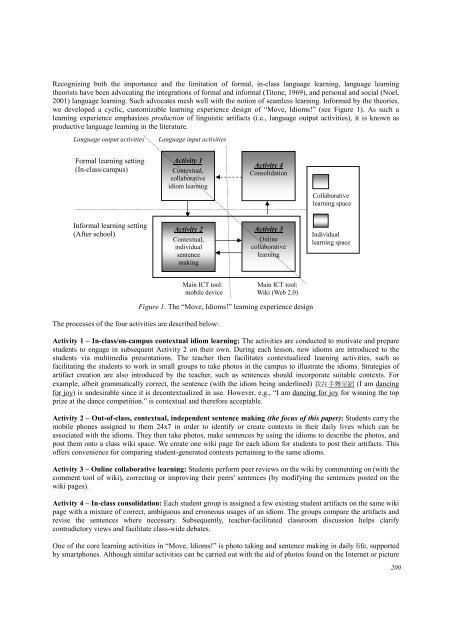Download Complete Issue in PDF - Educational Technology & Society
Download Complete Issue in PDF - Educational Technology & Society
Download Complete Issue in PDF - Educational Technology & Society
You also want an ePaper? Increase the reach of your titles
YUMPU automatically turns print PDFs into web optimized ePapers that Google loves.
Recogniz<strong>in</strong>g both the importance and the limitation of formal, <strong>in</strong>-class language learn<strong>in</strong>g, language learn<strong>in</strong>g<br />
theorists have been advocat<strong>in</strong>g the <strong>in</strong>tegrations of formal and <strong>in</strong>formal (Titone, 1969), and personal and social (Noel,<br />
2001) language learn<strong>in</strong>g. Such advocates mesh well with the notion of seamless learn<strong>in</strong>g. Informed by the theories,<br />
we developed a cyclic, customizable learn<strong>in</strong>g experience design of “Move, Idioms!” (see Figure 1). As such a<br />
learn<strong>in</strong>g experience emphasizes production of l<strong>in</strong>guistic artifacts (i.e., language output activities), it is known as<br />
productive language learn<strong>in</strong>g <strong>in</strong> the literature.<br />
Language output activities<br />
Formal learn<strong>in</strong>g sett<strong>in</strong>g<br />
(In-class/campus)<br />
Informal learn<strong>in</strong>g sett<strong>in</strong>g<br />
(After school)<br />
Language <strong>in</strong>put activities<br />
Activity 1<br />
Contextual,<br />
collaborative<br />
idiom learn<strong>in</strong>g<br />
Activity 2<br />
Contextual,<br />
<strong>in</strong>dividual<br />
sentence<br />
mak<strong>in</strong>g<br />
Ma<strong>in</strong> ICT tool:<br />
mobile device<br />
The processes of the four activities are described below:<br />
Activity 4<br />
Consolidation<br />
Activity 3<br />
Onl<strong>in</strong>e<br />
collaborative<br />
learn<strong>in</strong>g<br />
Ma<strong>in</strong> ICT tool:<br />
Wiki (Web 2.0)<br />
Figure 1. The “Move, Idioms!” learn<strong>in</strong>g experience design<br />
Collaborative<br />
learn<strong>in</strong>g space<br />
Individual<br />
learn<strong>in</strong>g space<br />
Activity 1 – In-class/on-campus contextual idiom learn<strong>in</strong>g: The activities are conducted to motivate and prepare<br />
students to engage <strong>in</strong> subsequent Activity 2 on their own. Dur<strong>in</strong>g each lesson, new idioms are <strong>in</strong>troduced to the<br />
students via multimedia presentations. The teacher then facilitates contextualized learn<strong>in</strong>g activities, such as<br />
facilitat<strong>in</strong>g the students to work <strong>in</strong> small groups to take photos <strong>in</strong> the campus to illustrate the idioms. Strategies of<br />
artifact creation are also <strong>in</strong>troduced by the teacher, such as sentences should <strong>in</strong>corporate suitable contexts. For<br />
example, albeit grammatically correct, the sentence (with the idiom be<strong>in</strong>g underl<strong>in</strong>ed) 我在手舞足蹈 (I am danc<strong>in</strong>g<br />
for joy) is undesirable s<strong>in</strong>ce it is decontextualized <strong>in</strong> use. However, e.g., “I am danc<strong>in</strong>g for joy for w<strong>in</strong>n<strong>in</strong>g the top<br />
prize at the dance competition.” is contextual and therefore acceptable.<br />
Activity 2 – Out-of-class, contextual, <strong>in</strong>dependent sentence mak<strong>in</strong>g (the focus of this paper): Students carry the<br />
mobile phones assigned to them 24x7 <strong>in</strong> order to identify or create contexts <strong>in</strong> their daily lives which can be<br />
associated with the idioms. They then take photos, make sentences by us<strong>in</strong>g the idioms to describe the photos, and<br />
post them onto a class wiki space. We create one wiki page for each idiom for students to post their artifacts. This<br />
offers convenience for compar<strong>in</strong>g student-generated contexts perta<strong>in</strong><strong>in</strong>g to the same idioms.<br />
Activity 3 – Onl<strong>in</strong>e collaborative learn<strong>in</strong>g: Students perform peer reviews on the wiki by comment<strong>in</strong>g on (with the<br />
comment tool of wiki), correct<strong>in</strong>g or improv<strong>in</strong>g their peers' sentences (by modify<strong>in</strong>g the sentences posted on the<br />
wiki pages).<br />
Activity 4 – In-class consolidation: Each student group is assigned a few exist<strong>in</strong>g student artifacts on the same wiki<br />
page with a mixture of correct, ambiguous and erroneous usages of an idiom. The groups compare the artifacts and<br />
revise the sentences where necessary. Subsequently, teacher-facilitated classroom discussion helps clarify<br />
contradictory views and facilitate class-wide debates.<br />
One of the core learn<strong>in</strong>g activities <strong>in</strong> “Move, Idioms!” is photo tak<strong>in</strong>g and sentence mak<strong>in</strong>g <strong>in</strong> daily life, supported<br />
by smartphones. Although similar activities can be carried out with the aid of photos found on the Internet or picture<br />
200

















